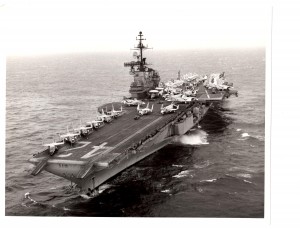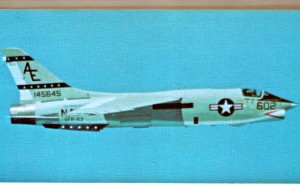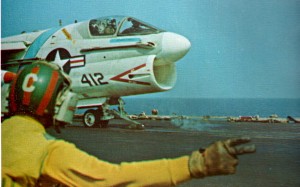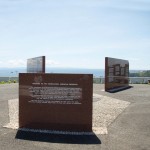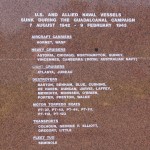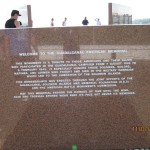Archive for March, 2011
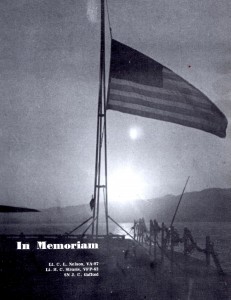 Today’s post was submitted by an old friend, Robert Schnell of Redding, California. Bob was a Radar Intercept Officer in the early 1970s, flying F-4 Phantoms with U.S. Navy Fighter Squadron 84 assigned to the aircraft carrier Franklin D. Roosevelt (CVA-42). I’ll let Bob tell the rest of his story…
Today’s post was submitted by an old friend, Robert Schnell of Redding, California. Bob was a Radar Intercept Officer in the early 1970s, flying F-4 Phantoms with U.S. Navy Fighter Squadron 84 assigned to the aircraft carrier Franklin D. Roosevelt (CVA-42). I’ll let Bob tell the rest of his story…
“The flight deck of a U.S. Navy aircraft carrier has been described as the most dangerous square footage you may trod. During flight operations ear-splitting jet engine noise, aircraft in motion, searing exhaust, jet engine intake forces so powerful it can suck a 200 pound man off the deck in a split second, spinning propellers and flight deck personnel moving among all this machinery on a confined area of about an acre in size demand a careful, deliberate choreography. It takes professional skill, knowledge and no small ability for all this activity to occur so as to get the primary mission accomplished: launching aircraft off the ship and into the air safely and efficiently. Recovery of those same aircraft during the landing sequence has its own set of rules. Even when all is done properly, as safely as possible and as efficiently as only time, training and practice may allow there still is the unknown, unforeseen circumstance that causes tragedy. Such was the case on board the USS Franklin Roosevelt aircraft carrier (FDR), CVA-42, in 1972 during a Sixth Fleet cruise in the Mediterranean Sea.
VFP-63 was a photo reconnaissance squadron flying RF-8’s which were unarmed Crusaders re-equipped with photo gear. The F-8 was equipped with an ejection seat that only promised a safe ejection if the plane was flying at least 200 feet above the surface and at a speed of at least 200 knots. It needed that much speed and altitude for the seat to function properly. The F-4’s ejection seat, by contrast, had a later model “0-0” seat; i.e., one could eject from the Phantom on the ground with no altitude or airspeed necessary. During an otherwise normal launch of an RF-8, one of those unforeseen acts happened. The plane was accelerating down the deck being pulled by the catapult. Then a portion of the underside where the catapult bridle attaches to the plane broke away. The plane was going about 100 knots and was about half the distance to the bow of the ship: moving too fast to brake and too slowly to get airborne. Without a more up-to-date ejection seat there was no way for the pilot to survive an attempted ejection. So he rode the plane until it fell over the bow into the water and was run over by the carrier. There was no hope of recovery. Lt. M.C. Steams was lost at sea.
The other accident involved an A-7 Corsair II from Attack Squadron 87 (VA-87). It also happened during a catapult launch sequence. In the Mediterranean during the summer the air is hot and humid. When a jet goes to 100% power for the catapult launch it also starts to pressurize the cockpit. Through a here-to-fore unknown set of climate-control switch positions the compression of the air inside the cockpit caused the humid ambient air to lower to the dew point where it turned instantaneously into fog. This blinded the pilot and he flew off the deck right-wing down and into the water. If he had any time to blow the canopy will never be known. It all happened in less than 5 seconds. Again, there was no hope of recovery. Lt. C.L. Nelson was also lost at sea.
Those involved in Naval Aviation who lose their lives in the performance of their duties, whether in peace or war, will always be remembered. In these two cases their coffins are the planes they flew, their tombstones are the waves of the Sea above and their memorials are the people who will never forget their ultimate sacrifice.”
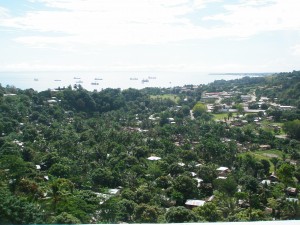 On a hill overlooking the beautiful and tranquil Pacific Ocean in Honiara, Solomon Islands stands an American Monument to the Naval and Marine Corps nightmare known as Guadalcanal. The first major United States Pacific offensive of WWII was ultimately successful, but at a cost that was horrific. Twenty-four U.S. naval vessels were lost – aircraft carriers, heavy cruisers, light cruisers, and destroyers. Their names echo in American naval history – Astoria, Hornet, Wasp, Atlanta, Cushing, Porter, Preston, Juneau, and on and on. The human cost was even higher – 1,592 Marine and Army troops and airmen killed in action – 5,041 U.S. Naval officers and sailors killed, most of those lost at sea in some of the most heroic and brutal naval combat in human history. One must add to that total the thousands of equally brave Japanese and Australians who also gave their lives in 1942 and 1943 in the tropical waters off Guadalcanal that came to be known as “Ironbottom Sound” to those who survived the carnage.
On a hill overlooking the beautiful and tranquil Pacific Ocean in Honiara, Solomon Islands stands an American Monument to the Naval and Marine Corps nightmare known as Guadalcanal. The first major United States Pacific offensive of WWII was ultimately successful, but at a cost that was horrific. Twenty-four U.S. naval vessels were lost – aircraft carriers, heavy cruisers, light cruisers, and destroyers. Their names echo in American naval history – Astoria, Hornet, Wasp, Atlanta, Cushing, Porter, Preston, Juneau, and on and on. The human cost was even higher – 1,592 Marine and Army troops and airmen killed in action – 5,041 U.S. Naval officers and sailors killed, most of those lost at sea in some of the most heroic and brutal naval combat in human history. One must add to that total the thousands of equally brave Japanese and Australians who also gave their lives in 1942 and 1943 in the tropical waters off Guadalcanal that came to be known as “Ironbottom Sound” to those who survived the carnage.
It’s been almost seven decades now – the brutality and death of the Battles of Cape Esperance and Savo Island and Tassafaronga have been replaced by the lush green background of the Solomon Island hills – and the once blood-stained waters washed clean by a deep calming blue marking the common resting place of men once mortal enemies, now resting together in peace. The words of Joseph Conrad were perhaps meant for this very place more than any other…
“May the deep where he sleeps rock him gently, gently, until the end of time.”
I encourage every reader of this blog to read James D. Hornfischer’s book “Neptune’s Inferno” to learn much more about the U.S. Navy at Guadalcanal. It is superb history, written by a master of the English language.
